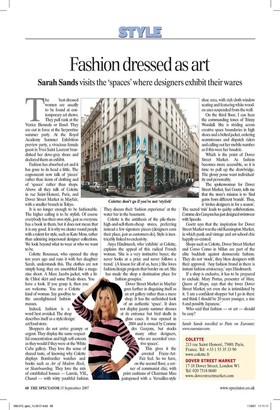Fashion dressed as art
Sarah Sands visits the 'spaces' where designers exhibit their wares T he best-dressed women are usually to be found at contemporary art shows. They pull rank at the Venice Biennale or Basel. They are out in force at the Serpentine summer party. At the Royal Academy Summer Exhibition preview party, a vivacious female guest in Yves Saint Laurent brandished her dove-grey shoes and declared them an exhibit.
Fashion has absorbed art and it has gone to its head a little. The cognoscenti now talk of 'pieces' rather than items of clothing and of 'spaces' rather than shops. Above all they talk of Colette in rue Saint-Honore, Paris, and Dover Street Market in Mayfair, with a smaller branch in Tokyo.
It is no longer enough to be fashionable. The higher calling is to be stylish. Of course everybody has their own style, just as everyone has a book in them, but it does not mean that it is any good. It is why we cluster round people with a talent for style, such as Kate Moss, rather than admiring impersonal designer collections. We look beyond what to wear at who we want to be.
Colette Roussaux, who opened the shop ten years ago and runs it with her daughter Sarah, understands this. The clothes are not simply hung, they are assembled like a magazine shoot. A Marc Jacobs jacket, with a little Chloe skirt and some Prada shoes. You have a look. If you grasp it, then you are welcome. You are a Colette kind of woman. Say goodbye to the unenlightened fashion masses.
Indeed, fashion is a word best avoided. The shop describes itself as a style/design/ art/food store.
Shoppers do not arrive grumpy or urgent. They display the same respectful concentration and high self-esteem as they would if they were at the White Cube gallery. They love the sense of shared taste, of knowing why Colette displays Bombardier watches and books such as Art of Modem Rock, or Skateboarding. They love the mix of established houses — Lanvin, YSL, Chanel — with witty youthful fashion.
Colette: don't go if you're not 'stylish' They discuss their 'fashion experience' at the water bar in the basement.
Colette is the antithesis of the pile-themhigh-and-sell-them-cheap stores, preferring instead a few signature pieces (designers earn their place, just as customers do). Style is inextricably linked to exclusivity.
Anya Hindmarch, who 'exhibits' at Colette, explains the appeal of this radical French woman. 'She is a very instinctive buyer; she never looks at a price and never follows a trend.' (A lesson for all of us, here.) She loves fashion/design projects that border on art. She has made the shop a destination place for fashion groupies.'
Dover Street Market in Mayfair goes further in disguising itself as an art gallery rather than a mere shop. It has the unfinished look of an authentic 'space'. It does not display jaunty summer dresses at its entrance but bird skulls in glass cases. It was opened in 2004 and is owned by Comme des Garcons, but stocks many other designers, who are accorded 'creative spaces'.
This gives it the coveted Frieze-ArtFair feel. So we have, on the second floor, a corner of communist chic, with print cushions of Chairman Mao juxtaposed with a Versailles-style shoe area, with rich cloth window seating and featuring white wooden axes suspended from the wall.
On the third floor, I can hear the commanding tones of Trimly Woodall. She is striding across creative space boundaries in high shoes and a belted jacket, ordering seamstresses and dispatch riders and calling out her mobile number as if this were her boudoir.
Which is the point of Dover Street Market. As fashion becomes more accessible, so it is time to pull up the drawbridge. The glossy posse want individuality and personality.
The spokeswoman for Dover Street Market, Sari Goetz, tells me that the store's mission is to 'find gems from different brands'. Thus, it 'invites designers in for a season'. The sacred 'mix leads to quirky collaborations. Comme des Garcons has just designed swimwear with Speedo.
Goetz says that the inspiration for Dover Street Market was the old Kensington Market, in which punk and vintage and art-school chic happily co-existed.
Shops such as Colette, Dover Street Market and Corso Como in Milan are part of the elite backlash against democratic fashion. They do not 'stock', they bless designers with their approval. 'Any fashion brand in there is instant fashion aristocracy,' says Hindmarch.
If a shop is exclusive, it has to be prepared to exclude. Mary Portas, presenter of Maly, Queen of Shops, says that she loves Dover Street Market, yet even she is intimidated by it. 'I am a confident shopper but I go in there and think I should be 20 years younger, a size 8 and possibly Japanese.'
Who said that fashion — or art — should be easy?

























































 Previous page
Previous page